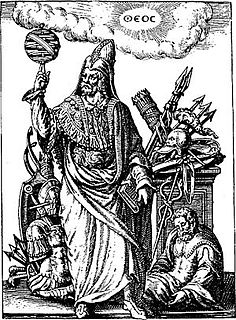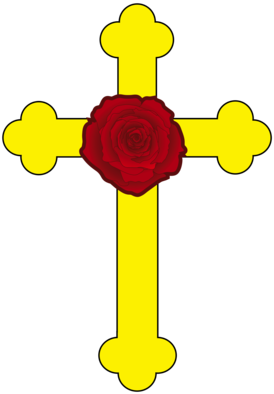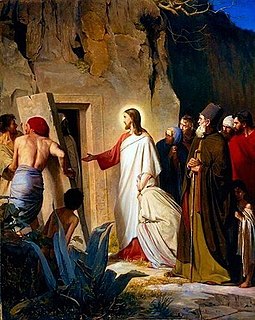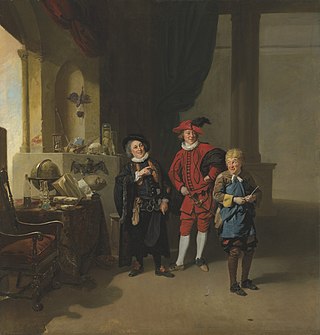The Parabola Allegory is a Rosicrucian allegory, of unknown authorship, dating from the latter part of the seventeenth century. It is sometimes attributed to German alchemist Henricus Madathanus. [1]

Rosicrucianism is a spiritual and cultural movement which arose in Europe in the early 17th century after the publication of several texts which purported to announce the existence of a hitherto unknown esoteric order to the world and made seeking its knowledge attractive to many. The mysterious doctrine of the order is "built on esoteric truths of the ancient past", which "concealed from the average man, provide insight into nature, the physical universe, and the spiritual realm." The manifestos do not elaborate extensively on the matter, but clearly combine references to Kabbalah, Hermeticism, alchemy, and mystical Christianity.

As a literary device, an allegory is a metaphor in which a character, place or event is used to deliver a broader message about real-world issues and occurrences. Allegory has occurred widely throughout history in all forms of art, largely because it can readily illustrate or convey complex ideas and concepts in ways that are comprehensible or striking to its viewers, readers, or listeners.
Contents
Bearing many similarities to The Chymical Wedding of Christian Rosenkreutz , it is steeped in alchemical imagery. It deals with the journey of initiation of an unknown narrator, who, after many trials, enters the Rose Garden and bears witness to the dissolution and reconstitution of a pair of royal lovers into a King and Queen.

Alchemy was an ancient branch of natural philosophy, a philosophical and protoscientific tradition practiced throughout Europe, Africa, and Asia, originating in Greco-Roman Egypt in the first few centuries AD.
Like The Chymical Wedding, the Parabola Allegory has the haunting quality of a dream. It was taken as the starting point by Viennese psychologist Herbert Silberer for an analysis of Freudian dream interpretation, in his major work Problems of Mysticism and Its Symbolism, where the Allegory is quoted in full. [2] [3] Silberer interprets the Allegory along Freudian lines then, pointing out the limitations of such an approach, goes on to interpret the narrative along alchemical/mystical lines, placing the story in the context of the Mystery traditions of the world's religions as an allegory of the Unio Mystica.

Vienna is the federal capital, largest city and one of nine states of Austria. Vienna is Austria's primate city, with a population of about 1.9 million, and its cultural, economic, and political centre. It is the 7th-largest city by population within city limits in the European Union. Until the beginning of the 20th century, it was the largest German-speaking city in the world, and before the splitting of the Austro-Hungarian Empire in World War I, the city had 2 million inhabitants. Today, it has the second largest number of German speakers after Berlin. Vienna is host to many major international organizations, including the United Nations and OPEC. The city is located in the eastern part of Austria and is close to the borders of the Czech Republic, Slovakia, and Hungary. These regions work together in a European Centrope border region. Along with nearby Bratislava, Vienna forms a metropolitan region with 3 million inhabitants. In 2001, the city centre was designated a UNESCO World Heritage Site. In July 2017 it was moved to the list of World Heritage in Danger.

A psychologist studies normal and abnormal mental states, cognitive, emotional, and social processes and behavior by observing, interpreting, and recording how individuals relate to one another and to their environments. To become a psychologist, a person often completes a graduate university degree in psychology, but in most jurisdictions, members of other behavioral professions can also evaluate, diagnose, treat, and study mental processes.
Herbert Silberer was a Viennese psychoanalyst involved with the professional circle surrounding Sigmund Freud which included other pioneers of psychological study as Carl Gustav Jung, Alfred Adler and others. He had a background in athletics and sports journalism.














